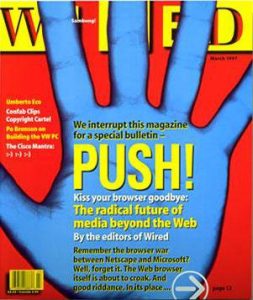 Back in the 1990’s there was a company called PointCast that thought it had discovered internet gold. Get this, they made a screen saver that pushed fresh content, like news and stock quotes, to your desktop.
Back in the 1990’s there was a company called PointCast that thought it had discovered internet gold. Get this, they made a screen saver that pushed fresh content, like news and stock quotes, to your desktop.
They became huge and many tech magazines heralded push technology as a revolutionary change in how people would consume information over the internet. Wired Magazine said, “Kiss your browser goodbye: The radical future of media beyond the Web”
Back in those prehistoric days of the internet, if you wanted information, you had to request it. If you wanted your email as soon as it arrived you had to keep asking the the server if there was any new mail yet. Sort of like children in the back of the car asking “Are we there yet?” every five minutes.
What PointCast figured out was that you could broadcast information to any machine, and as long as that machine was listening, it would receive the updated information. Sort of like the way that on your phone you can get a SMS or WhatsApp message.
Yes, sending someone data/content without them asking for it was considered a “technology” and this new technology was going to revolutionize the world according to all of the really smart people at the time.
Believe it or not, this simple technology, the ability to send people news and stock quote updates, resulted in a valuation of PointCast of $450 million.
And that wasn’t just an imaginary valuation. NewsCorp made an offer to buy PointCast for $450 million. The CEO of the company, Christopher Hassett, turned the offer down because he felt the company had the potential to become even bigger.
The board of directors disagreed and fired Hassett and the company tried to do an IPO at a $250 million valuation. For those of you not good with the maths, that’s $200 million less than what NewsCorp offered.
But that plan got pulled, due to lackluster investor interest, and PointCast decided to partner with Microsoft. That deal eventually fell apart and the company was ultimately sold for the princely sum of $7 million.
The point of today’s history lesson is to illustrate the fact that one should never confuse the potential value of a technology with the ability of a business to capitalize on that technology.
The fall of PointCast was not the end of push technology. SMS messages work on a push model. IMAP email can use a push model. Push technology is still around and we use it constantly even though PointCast has been forgotten.
Part of the reason for PointCast’s failure was the fact that utilizing a technology in a unique way is a one-trick pony. All PointCast could do was push you information that it licensed from other sources. Once Microsoft and Netscape integrated the Channel Definition Format (CDF) into their browsers, anybody could push information to users.
Blockchain reminds me a lot of push technology.
Blockchain, itself, doesn’t do anything. It’s a technology. It might be a technology that may lead to some revolutionary applications, but the, admittedly brilliant, concept of blockchain is simply a technology. In many ways, it is similar to push technology in that, while push technology is in widespread use today, almost any company that had as it’s core selling point that it was push-based is no longer around.
You can’t take a bad idea and slap a little blockchain on it and make it into a good idea. It doesn’t work like that.
Ten years from now, blockchain may be baked into thousands or millions of products that people use every day. Much like I get my emails and SMS messages pushed to me today. However, it will be because of what the blockchain allows people to do, rather than because . . . blockchain.
The reason why most people don’t know that SMS uses a push model or that their Gmail uses push is because the technology faded into the background and people, instead, built useful products which simply utilized the technology.
The best technologies are the ones you don’t think about.
Windows, MacOS, even Linux, all have graphical user interfaces. People don’t want to know what is going on behind the scenes when they drag and drop a document or copy and paste some text. All of the heavy lifting is done out of the view of the user.
That’s what a good technology application does.
It also explains why, despite massive amounts of press, crypto has yet to really gain deep market penetration. It’s estimated that maybe 5% – 7% of people in the world own any sort of crypto-currency or tokens despite about 35% of people surveyed saying they’ve heard of Bitcoin.
Why?
Because, in their current format, they’re too complicated to use. Nobody wants to think about private and public keys and creating hashes. They don’t care about proof of work. People want buying and selling crypto to be as easy as logging into their brokerage account and buying 100 shares of CocaCola stock.
They don’t want to write down some secret key and put it in a safe deposit box and store their crypto on a hardware wallet and remember some overly complex password just to buy a pack of gum.
Even with smart contracts, people don’t even care about how dumb contracts work. They want everything handled behind the scenes seamlessly.
People need to quit thinking of blockchain as the product and start thinking of blockchain as a tool. Ultimately, that is all it really is and in a few years the only people that will know what a blockchain is are some geeks that have to write the code. The general public will be as aware of blockchain as they are of push technology.